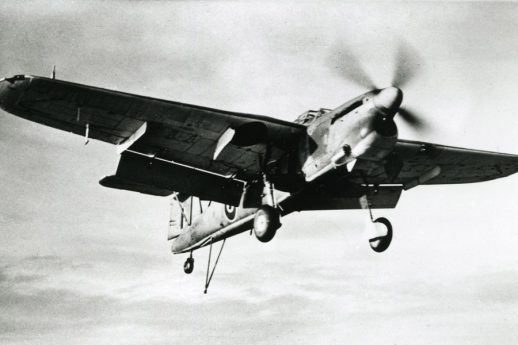
Words by Neil Thomson, photographs by David Titlow
*
Darling, darling, just in case
Rivets fail or engines burn
I forget the time and place
But your flesh was sweet to learn
‘Elegy Just in Case’ – John Ciardi, 1944
*
There is an almost universal practice amongst airmen during wartime of leaving a letter, prior to operations, to be sent on by others in the event of them being lost. The American poet John Ciardi flew missions in B-29 Bombers during the dénouement of the Second World War, high above the immolated wooden cities of Japan. He survived, but his poem takes the form of one of these many thousands of letters – perhaps fifty-five thousand from RAF Bomber Command alone – that were sent on by the comrades of the fallen and lost, their authors’ messages sent from beyond the grave as they burned in fuselages or drowned in freezing seas. The Imperial War Museum in London has a collection of these letters and they are, without exception, incalculably sad and beautifully brave.
Early on the morning of 28 May 1944, Sub-Lieutenant David Andrew Titlow of 831 Squadron, Fleet Air Arm flew his Fairey Barracuda into a small hill outside Crieff in Perthshire in terrible weather. He and his three fellow crew members, Sub. Lt J.W Friend, Sub Lt. R.N Robbins and LAC A.B Sim were killed instantly. Perhaps due to youthful confidence and the fact that he had yet to be fully bloodied in combat, he left no letter behind; all his family received was this telegram from the Admiralty:
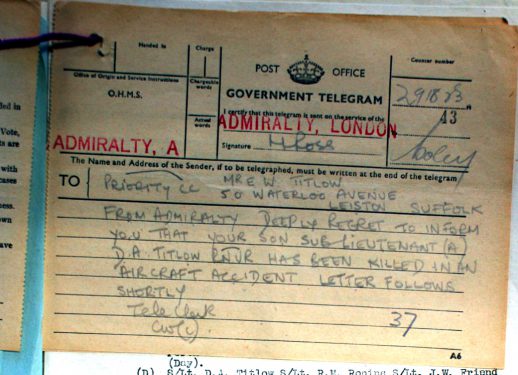
Seventy-two years later, I am with the sub-lieutenant’s great nephew, also named David after his lost great uncle. We are visiting David’s parents in the small village of Peasenhall in Suffolk. Knowing my interest in all things flying, David’s father Peter produces a photo album of old black and whites. The pictures show a handsome young man stood grinning next to a Tiger Moth, obviously elated after another round of circuits and bumps as he learns to fly during his basic training. I think of my favourite sound in the world: wind whistling through the wires of an old biplane on take-off into the elements of sky, rain and cloud, denying the fundamental laws of gravity in a craft made only of wood, dope and metal. There is a glint in his eyes in these old photographs that the brotherhood of pilots anywhere would recognise; as Gillespie Magee writes in his poem ‘High Flight’, ‘I have slipped the surly bonds of earth…’
He looks hooked and devoted to the higher power of flight. I’ve seen that look on the faces of friends who fly for Virgin Atlantic and those who fly fast jets for the RAF – the all-encompassing maelstrom of the Second World War was, I imagine, an aside to David Titlow. A distant thunder. They were going to let him go flying and that was the most important thing to this leather-jacketed young man. He had heard the noise and had had the calling to aerial prayer.
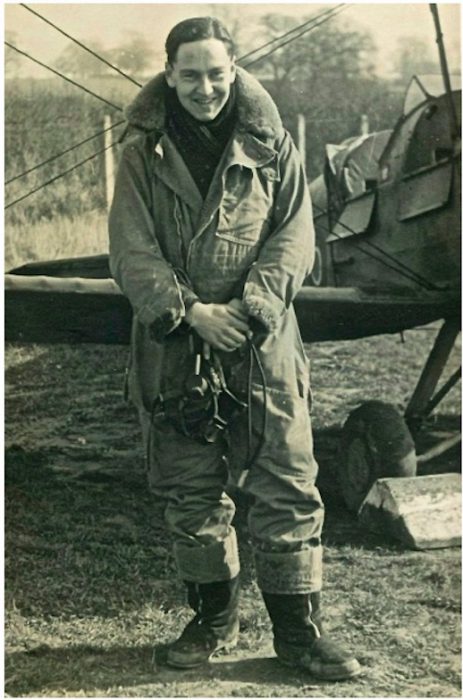
An idea forms. David and I will drive to Scotland and visit the scene of the accident. As we are both underemployed freelance photographers this is of no particular effort – we have travelled together many times, once across Argentina for a month, both with broken hearts, and on other countless assignments before and after. He is one of my closest and dearest friends; we could drive a million miles together without exchanging a word. The trip would be a meditation: for David a pilgrimage, for me another opportunity to commune with the spirits I had visited during the Phantom Fields and Ghost Squadrons photographic project I had been working on. The difference was that this time the spectre had a name, and an affinity with people close to me. The trip’s significance was only amplified by the lack of commissioning editors and deadlines. We were going to do it because it meant something to both of us.
One Sunday morning a few weeks later, we met outside at a private members’ club in East London – itself owing its existence to the high-explosive redesign of London by the Luftwaffe during the Blitz – and set off. Perhaps we should have flown up, but the anxieties and tedium of modern air travel – seemingly engineered to remove the experience of flying – seemed somehow inappropriate for this trip. Better to hear our own engine and be able to wind down the window. As always, I drove. Being a passenger has never sat well with me.
According to Admiralty records, Titlow’s Fairey Barracuda 11 call sign LS520 departed from the Royal Naval Air Station at Machrihanish and was due to land at RNAS Hatson on the Orkney mainland some three hours later, but failed to arrive. He was due to depart Hatson shortly afterwards to join his colleagues on 831 Squadron aboard the aircraft carrier HMS Victorious; it would have been his first operational deployment.
There are no surviving examples of the Fairey Barracuda: all were either lost during, or scrapped after, the war. A quick search reveals an ungainly looking aircraft with a huge, high wing, essential for generating the lift necessary for taking off from short carrier decks. Lacking the grace and beauty of its contemporaries like the Spitfire, the aircraft has been largely forgotten. Designed as a torpedo and divebomber, it is perhaps only famous for Operation Tungsten, a partially successful attack by the Fleet Air Arm on the German Battleship Tirpitz which occurred a month before the accident. Five aircraft were lost and the Tirpitz badly damaged. It seems the sea, rather than the land, was the Barracuda’s natural environment. Watching old film of Barracuda carrier operations reminds one of awkward gannet fledglings clambering into the air from a rock face, then transforming into supreme maritime hunters when on the wing and at sea.
Journeys north are always my favourite: the space around the land and the sky seems to open up with each passing mile. In some ways this journey, an investigation into an incident from nearly seventy years ago, was an act of time travel. We moved through a landscape that must have changed immeasurably in that brief time, owing to the hum and urges of commerce and technology.
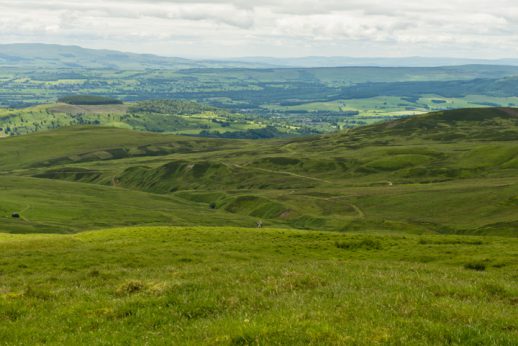
David and I share the desire to visit places where things of personal significance have happened. I have long believed that history leaves echoes, semiotic ghosts, if you like, and that even if there is no physical evidence remaining at these locations, there is still perspective and insight to be gained from travelling to and communing with them.
Meall Tarsuinn is an unremarkable Scottish hill not far from the town of Crieff. Ordnance Survey has its elevation at 648 metres, and it is the three-thousandth highest peak in the British Isles. We set off from our hotel, a place that could almost have belonged to my Scottish grandmother, complete as it was with a West Highland terrier and a photograph of the Pope in the kitchen, and drove the few miles outside town on a fresh summer morning.
We had telephoned ahead and arranged access with Mary McCall Smith, the lady who owns the upland sheep farm on which Meall Tarsuinn is situated, and she kindly pointed us in the right direction. Amazingly, a visiting farm contractor mistook us for shepherds – perhaps the journey had rid us of the sheen of London and The South. We started up the hill, pausing now and again to watch the balletic dance of border collies and ewes of a working farm. The livestock thinned out as we gained altitude and the wind picked up – only a couple of sheep skulls, reminders that the winters here can be unforgiving, were evidence that we were still on a farm. According to the Admiralty records the aircraft had impacted on the west side of the hill, but it was impossible to tell exactly where. Nowadays a full board of enquiry would be formed to investigate such an accident, but such events were so frequent during the war that only the bodies were recovered and the condition of the airframe assessed, in case it could be returned to service. Barracuda LS 520 could not and so it was officially written off.
We combed the west side of Meall Tarsuinn looking for evidence of what had happened in 1944, but found nothing. Records show that the majority of the fuselage was recovered but the Barracuda’s engine was deemed beyond repair and too heavy to be moved. It wouldn’t have taken long for it to be absorbed by the wet, boggy and peaty ground of this hill. I imagined it sleeping beneath our feet alongside dinosaur bones and flint arrowheads.
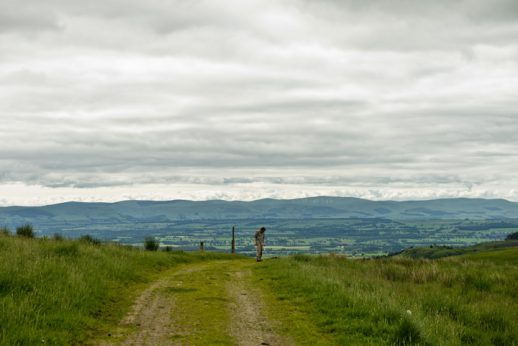
Sensing that David might like some time alone with his thoughts, we separated. I continued in vain to look for debris, startling a huge off-white mountain hare just emerging from its winter camouflage. I also saw young red deer sheltering from the wind. Human conflict and the natural world might, at first, be regarded entirely at loggerheads, but consider the once very rare black redstart. Its population exploded in London after 1941, as it found perfect nesting and breeding locations amongst the empty ruins left by the Blitz.
David set off for the summit to find the cairn. My late father had had a lifelong interest in the history of Scotland and the Clans he descended from, and I remember him once telling me on another, more northern Scottish hill, that in Highland folklore, each man of a Clan would place a stone in a pile before they fought in battle. Those who survived would remove their stone afterwards, and the remaining stones would be built into a cairn to honour the dead. I couldn’t help but recall Ciardi’s poem and the letters sent to loved ones by dead aircrew. David had brought a laminated photograph of his great uncle along to place on the cairn as an act of remembrance. It made me think of the old Scottish Gaelic blessing ‘Cuiridh mi clach air do chàrn’, which translates as ‘I’ll put a stone on your cairn’.
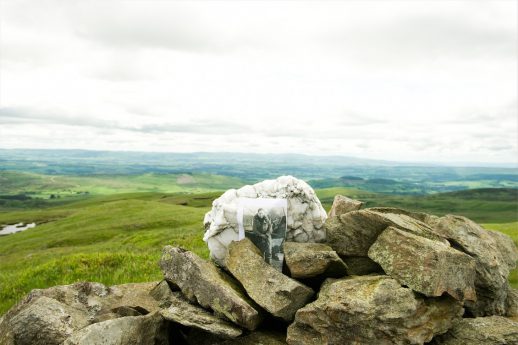
We returned to the farmhouse for tea and Mrs McCall Smith spoke of how her father remembered the morning of the accident. He recalled a hearing a huge impact but seeing very little as the hill and farm were covered in thick fog – perhaps feared by airmen more that any actual enemy, being any pilot’s worst nightmare and adversary – and almost certainly the cause of the incident. He had set out up the hill but found only the smell of aviation fuel, twisted aluminium and the shattered bodies of four young men. A look of recollection passed across Mrs McCall Smith’s face and she asked us to wait. She returned, having remembered something from her childhood: a piece of the fuselage of LS520 that had sat in a barn on the farm since the accident, and that she remembered seeing on a shelf as a child. Incredibly, we had found something tangible to connect the aircraft and David’s great uncle to this hill. It has become a talisman to be touched: a charmed object and a holy relic for David’s family.
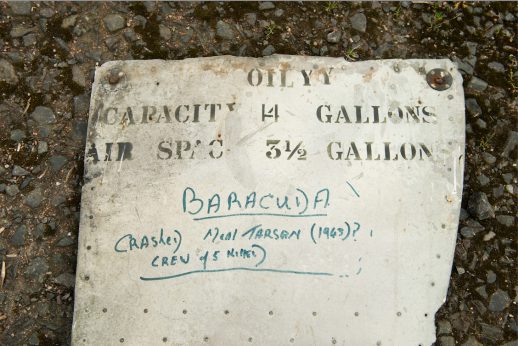
There was to be another twist to the story. We had been helped out greatly in researching the accident by Alan Leishman of the Dumfries and Galloway Aviation Museum. Hidden amongst the expected documents he had helped us find was a letter from someone the family didn’t recognise.
*
Jean K. Petch
6 Elms Avenue
Muswell Hill
London N.10
12.6.44
The Secretary
To The Admiralty
Whitehall
Dear Sir,
A letter written to Sub/Lt David Titlow R.N.V.R 831 Squadron R.N.A.S c/o P.O. London, was returned to me & enclosed was a slip of paper stating he had been killed in action. I was a very great friend of his and would like to write to his parents who live in Suffolk. Will you please be good enough to forward me their address.
Thank you very much.
Yours truly,
(Miss) Jean K Petch
*
Neither David or his father had ever heard of the author of the letter and no one in the family recalls receiving a letter from a Miss Petch. A brief love affair, perhaps, passion heightened by the uncertainties of life during wartime. I imagine rushed rendezvouses snatched in a blacked-out London before duties separated them, neither knowing if and when they would ever see each other again. The letter remains in the Admiralty archives and seems a potent icon of lives not lived, the rushed and grief-stricken handwriting a signifier of lost love, marriage even, of children not born.
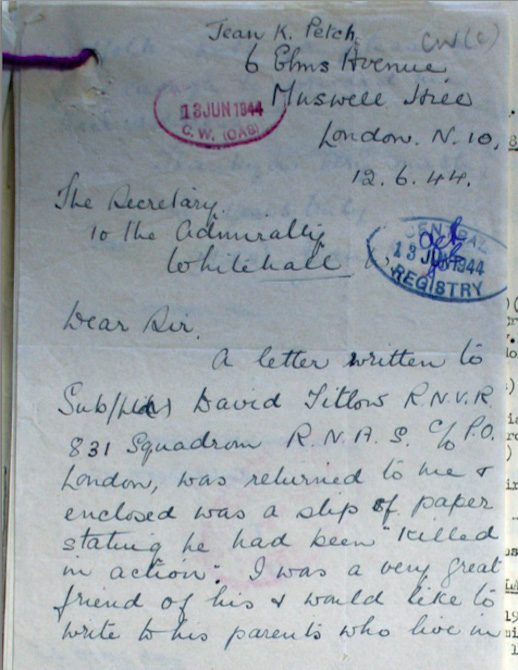
We drove off in silence. This insignificant hillside had provided
the poignant focal point of a trip long-planned, and for David and his family, a conclusion, perhaps, to years of wondering about the fate of a lost family member. We left Meall Tarsuinn to the wind, sun, rain and seasons. The remains of Sub/Lt Titlow were returned to his family shortly after the accident, but in many ways I couldn’t help thinking he was still there in some way, and will be across the abyss of time. I thought of the title of one of my favourite pieces of music: Sparklehorse’s ‘Dreamt for Light Years in The Belly of A Mountain’.